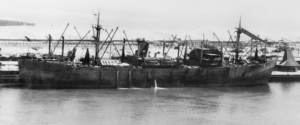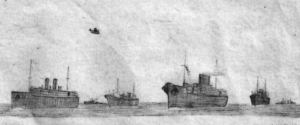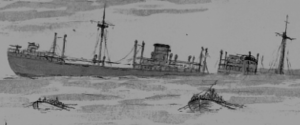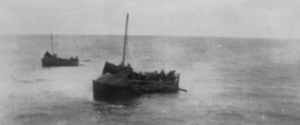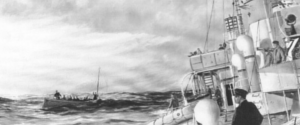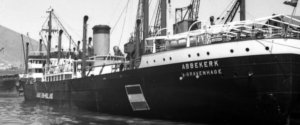Escaping Singapore at last

30 January 1942 Abbekerk has been anchored for almost three weeks and nothing much has happened on board for the last 2 weeks. Still bombers fly over the ship every day and more and more smoke is erupting from the city. The crew is starting to grumble and the officers are now also starting to insist to the Captain to leave. For the umpteenth time the Captain leaves for the shore. But this time he arrives back with good news. He successfully contacted Batavia and he orders the ship to get ready to leave.
A launch returning from an island in Keppel Harbour at Singapore after Royal Engineers had set fire to oil storage tanks there, January 1942.
(http://ww2today.com/)The Captain made himself very popular with this action and with renewed vigour the ship was readied for sea and to steam southwards at full speed. If we had had paddles we would all have helped to speed the ship along and away from Singapore.
While we were still there, there was a very large number of bombers that flew over at high altitude, this time in the opposite direction, away from Singapore. We wondered about their target but luckily we heard no whistling all we wanted was to get away as quickly as possible. Our cabins which, while at anchor with no wind, had become hotter and hotter were now being cooled down by a fresh wind generated by the speed of the ship. A cooler cabin also helped to smooth our stretched-out nerves and we looked with more hope towards the future.What was in store for us? We found out soon enough!
Ass. Engineer Adriaan Kik
From SIngapore we didn’t sail in convoy: the ship made off alone and at full speed to avoid trouble with the Japs. All guns ready to fire but happy to leave. Next stop was Oosthaven, at the Lampoon bay in the southeast tip of Sumatra.
Gunner Walter MacNab
Merchant Shipping losses in the area 27 january Harpa (British): The tanker struck a mine and sank in the Singapore Strait with the loss of 39 of her 40 crew. 29 january Boelongen (Dutch): The cargo ship was bombed and sunk at Padang, Dutch East Indies by Japanese aircraft. Buyskes (Dutch): The cargo ship was bombed and sunk at Padang by Japanese aircraft. Elout (Dutch): The cargo ship was bombed and sunk at Padang by Japanese aircraft.
Poelau Tello (Dutch): The cargo ship was bombed and sunk at Padang by Japanese aircraft. 3 february Katong (British): The cargo ship was bombed and sunk in the Strait of Malacca off Palembang, Dutch East Indies by Japanese aircraft with the loss of all but five crew. Loch Ranza (British): The cargo ship was bombed and sunk in the Strait of Malacca by Japanese aircraft with the loss of 18 of the 50 people aboard. Survivors were rescued by Subador. Norah Moller (British): The cargo liner with refugees from Singapore by way of Java was bombed and sunk in the Bangka Strait by Japanese aircraft. 57 women and children survivors, 28 of whom were wounded, were rescued by HMAS Hobart and 13 of the ship's crew were rescued by HMS Tenedos. Pinna (British): The tanker was bombed and damaged in the Strait of Malacca by Japanese aircraft. She was attacked again the next day and was beached and abandoned with the loss of 20 of the 45 people aboard. Survivors were rescued by Subador. Talthybius (British) The cargo liner was bombed and sunk at Singapore by Japanese aircraft. She was later salvaged and passed to the Imperial Japanese Navy as Taruyasu Maru. 4 february Togian (Dutch): The cargo ship was shelled and damaged in the Timor Sea off Koepang, Dutch East Indies by I-56. She was scuttled off Koepang on 22 february Van Lansberge (Dutch): The cargo ship was torpedoed and damaged by I-55 , in the Java Sea south of Makassar, Dutch East Indies. She was scuttled by HrMs Pieter de Bitter. 5 february
Empress of Asia (Canadian):The troopship was bombed and sunk off Singapore by Imperial Japanese Navy aircraft with the loss of 16 of the 1,820 people aboard. Tidore (Dutch): The cargo ship was bombed and sunk in the Indian Ocean south of Sumbawa, Dutch East Indies by Japanese aircraft. 7 february Van Cloon (Dutch): The cargo ship was torpedoed and sunk in the Java Sea south of Bawean, Dutch East Indies by I-55 . 187 survivors were rescued by USS Isabel. 9 february Meroendoeng (Dutch): The cargo ship was torpedoed and sunk in the Indian Ocean by I-65 .

